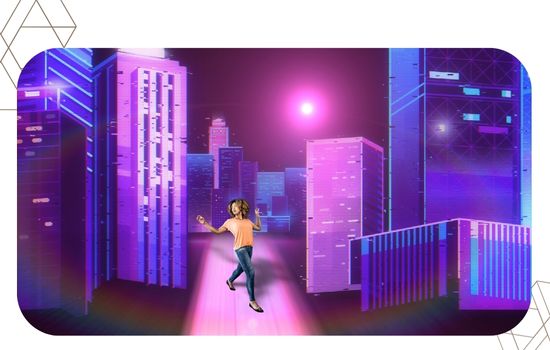Advertisements
A revealing analogy and at the end a FAQ section to clarify doubts Advantages and disadvantages of the metaverse in 2025

In this analysis, you'll find a summary to guide you, followed by an exploration of the benefits and challenges of the metaverse today, along with concrete examples.
Summary
- Introduction to the concept and current context.
- The advantages Main: education, economy, connectivity.
- The disadvantages most relevant: technological gap, privacy, addiction.
- Practical examples and analogy for better understanding.
- Conclusion with a critical and proactive perspective.
- Frequently asked questions.
When we talk about Advantages and disadvantages of the metaverse in 2025, we refer to an era in which the union between the physical and the virtual gains intensity.
This emerging dimension uses technologies such as augmented reality, virtual reality, blockchain, and artificial intelligence to redefine how you work, learn, shop, and socialize.
Advertisements
The outlook for 2025 shows some interesting developments: for example, in the manufacturing industry, a University of Surrey study found that the metaverse helps re-empower human participation through digital twins of production plants.
But at the same time, obstacles persist: platform fragmentation, high costs, and infrastructure barriers.
So how do we assess this hybrid world that promises so much? Let's take a close look at its pros and cons.
Advantages of the metaverse in 2025
Immersive education and training
One of the most tangible advantages is the transformation of traditional teaching.
In virtual environments, you can simulate laboratories, visits to remote sites, or practical exercises without physical risk.
This opens up possibilities to teach you through action and not just reading.
Thanks to immersion, learning can be deeper and more motivating.
For example, a medical center could use virtual environments for a student to practice surgical interventions in realistic scenarios before touching a real patient.
New economic and consumption models
The digital economy is enriched by virtual experiences and assets.
Brands are using three-dimensional platforms to offer products, services, and experiences that were previously limited to the physical.
According to a report, the metaverse could generate up to US$$5 trillion in economic value by 2030 if ecosystems are well managed.
An original example: a fashion boutique opens a “store” in a virtual environment where you try on a dress on your avatar, purchase it as a digital item, and also have it shipped to your home as a physical item.
This duality effectively connects the virtual and the real.
Global connectivity and unlimited creativity
The possibility of connecting across borders is amplified.
You can collaborate in real time with people on other continents in environments that simulate physical presence.
In addition, creativity is unleashed: designing worlds, building, exploring, imagining without so many physical limitations.
Consider an analogy: the metaverse is like going from watching a movie on TV to inhabiting it as the main character; you're no longer a spectator, you're an active participant.
This transition opens new doors for interaction and participation.

Read more: History of the first video games
Disadvantages of the metaverse in 2025
Technology gap and cost of access
A major disadvantage is that access is not yet universal.
Virtual and augmented reality devices remain expensive, and high-speed connectivity is not guaranteed in many regions.
Thus, someone in a rural area or with limited resources could be excluded from many of the experiences being built in this new ecosystem.
Privacy, security and governance
The virtual environment multiplies risk vectors: biometric data collection, digital identity, real-time behavior.
Platforms must respond to new security challenges.
In other words, entering these worlds isn't just a matter of technology, but also of trust, regulation, ethics, and digital rights.
Possible alienation and health effects
Spending long hours in immersive environments can lead to physical disconnection, a sedentary lifestyle, and a loss of real contact.
A study warns that prolonged virtual exposure could affect cardiovascular health.
And you may not notice it right away, but it's like starting to prefer living inside a digital model and neglecting the real garden:
The model has its magic, but it doesn't replace the smell of the grass, the wind on your face, or the texture of the bark.
Balance, examples and analogy
To summarize: the advantages The goals of the metaverse are to empower education, open business models, and globalize collaboration.
The disadvantages They reside in technological exclusion, privacy risks and the imbalance between physical and virtual reality.
Example 1A manufacturing company installs a digital replica of its production line to train new technicians without shutting down the plant; material savings and training time are significantly reduced.
Example 2A young gamer spends so many hours in virtual worlds that he neglects physical activities and real friendships, which generates anxiety when trying to return to the everyday world.
The aforementioned analogy of switching from watching a movie to living in it helps us understand that the metaverse is not just a new screen, but a qualitative change in the digital experience.
But, like any change, it requires preparation, clear boundaries, and strategy.
Conclusion
Evaluate the Advantages and disadvantages of the metaverse in 2025 It means recognizing that this phenomenon is not just hype, nor a magic solution without challenges.
You, as a user, professional, or citizen, can benefit from this by approaching reality with information, judgment, and prudence.
The invitation is to educate yourself, experiment purposefully, remain critical of technological promises, and, above all, to balance virtual and physical life.
The metaverse has the potential to transform how you work, learn, create, and connect, but it can also increase inequalities, vulnerabilities, and disconnection if not designed with equity and humanity in mind.
In the end, the question isn't whether the metaverse will arrive (it's already underway), but how and with whom we're going to build it.
You may be witnessing an era that redefines digital, but you can also play your part in making this new landscape inclusive, safe, and enriching.
Read more: The Metaverse: What It Is and How It Could Transform Everyday Life
Frequently Asked Questions
Is it necessary to have a virtual reality headset to participate?
Not necessarily. Some metaverse experiences can be accessed via computer or mobile device.
However, for full immersion, AR headsets, sensors, or glasses are often required.
When will the metaverse be “massive”?
There is no precise date.
While some platforms are already operational, widespread adoption will depend on cost reduction, improved connectivity, and interoperability between virtual environments.
Can people with limited resources participate?
Yes, but they may be at a disadvantage if they don't have the right device or a fast connection.
The technological gap is a clear disadvantage today.
Will the metaverse replace real social life?
It shouldn't be interpreted that way. It's a complementary tool, not a replacement.
Losing contact with the real world would be a risky act.
What precautions should I take when using virtual environments?
Pay attention to your data privacy, the time you spend online, maintaining real physical and social contact, and choosing platforms that respect security standards.